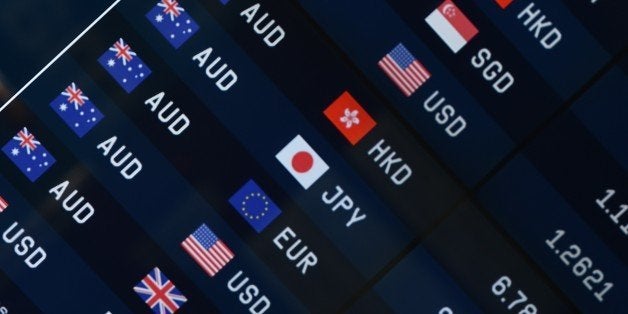
The key to understanding the bank scandal unfolding right now hangs on what your understanding of "fixed" is.
The Justice Department expects to charge at least one big bank with "fixing" the multi-trillion dollar global currency market by colluding with other banks to set key exchange rates, according to The New York Times. The DOJ may get several other big banks to admit guilt in the scheme. U.S. “prosecutors are aiming to file charges against at least one bank by the end of the year,” the NYT’s Ben Protess and Jessica Silver-Greenberg write.
If this sounds similar to the Libor rigging scandal that unfolded a couple years ago, in which banks colluded to set the interest rate used to price more than $300 billion in securities, it should. Both scandals exploited the same well-intentioned motive: To give order to chaotic markets.
Markets rely on structure -- and not just how, when or what can be traded. Banks, investors, traders, and speculators need structure in prices -- reference points that give them information and help them trade. Reference points, in the form of benchmark securities and indexes, are important market fundamentals.
Unfortunately, the same thing that makes market standards useful makes them targets of manipulation.
That’s pretty much how we get to the latest benchmark rigging scandal, this time in the “Wild West” $5.3 trillion-a-day world of currency trading. The banks under investigation are accused of colluding to set benchmark WM/Reuters foreign exchange rates, known as "the fix."
The fix is set for all major currencies every day by taking the median price of trades that occur 30 seconds before 4 p.m. London time, and 30 seconds after. The exchange rates set by the fix determine the prices that most big investors will pay. They're also used by banks to value their positions.
Bloomberg first reported in June that banks and selected trading partners were colluding to trade at certain rates in order to try to influence the day’s fix so they could sell currencies to clients at an elevated or deflated level. Traders shared a private online chat room to communicate about trades that would affect the fix.
The key to understanding the currency trading scandal is the difference between the fix, and fixing.
The fix is institutionalized, normalized, transparent, and important to regulators, traders, and investors. Fixing, according to the Times report of the DOJ investigation, was institutionalized and normalized. It was transparent, if you were in the chatroom. It was important to some traders, seemed to be tolerated by regulators, and apparently was unknown to investors.
In short, fixing corrupted the fix.
There’s a reason the head of the Bank of England said in March that the currency scandal was “as serious as Libor, if not more so.” The foreign exchange market is the largest and most liquid in the world. Daily volume is $5.3 trillion, and prices are quoted to four decimal places. (That’s hundredths of a penny in U.S. dollars.)
The harm in this case -– beyond the notion of sullying fair markets -– is mostly to very large currency funds, and is hard to quantify. Speaking to Bloomberg in June, the London School of Economics’ Tom Kirchmaier went straight to the theoretical: “Any rigging of the price mechanism leads to a misallocation of capital and is extremely costly to society.” Retail clients are hurt in the currency exchange market by absurd fees and unfavorable exchange rates.
There is a way the behavior of the banks under investigation reflects the behavior across financial markets. When the scandal first broke, the Financial Times’ Izabella Kaminska pointed out that big traders concentrating transactions within a short time to move markets is a characteristic of most markets. “In some sense,” she wrote, “that’s what trading is about.”
The difference here is that this wasn’t just traders using these tactics to boost their own portfolios, but to beat clients to the punch and make them buy for more and sell for less.

